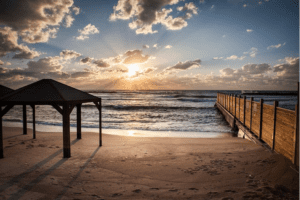There’s something for everyone in Tel Aviv, and that’s certainly true of the 13 beaches that line the coast of this 24-hour city. While the beaches are open to everyone (except for the religious beach, which has separate hours for men and women), each one has its own vibe and personality.
The Hilton TLV Beach
Located just below the Hilton Hotels, is known as they gay friendly beach (but it’s open and welcoming for everyone). It is also one of the city’s most accessible with two beach wheelchairs available on a first-come, first-served basis during official hours. There is also an accessible ramp stretching down almost. until water point.
Dog friendly Beach
You only have to be in Tel Aviv for five minutes to realize Tel Avivians love their dogs; a lot. They love them so much there are four dedicated dog beaches. So, if you like pooches, but don’t want to share the beach with them (or if you love them so much you can’t think of anything better than swimming with the doggies), here’s the rundown. Dogs are welcome at the Hilton Beach; at the beach south of Tel Baruch Beach; at Alma Beach (Charles Clore Beach); and south of Givat Aliyah Beach, which is a quiet spot in Jaffa.
“Religious” Beach
Family friendly – Gordon, Frishman and Tel Baruch Beaches
If you are traveling with kids and want a less crowded and more family friendly beach experience, head north of Tel Aviv to Tel Baruch beach. With its position away from the main hotel and beach drag, it’s a great spot for a family day out and less packed and hectic than the beaches further south.
Tel Aviv Beach Rules
No matter where you set up your spot, don’t forget that even the free and easy beaches of Tel Aviv have safety rules you must follow. Only swim when and where there are lifeguards on duty. They operate from May-October and start their shifts at 7am until the late afternoon/early evening, depending on the time of year. During these hours, they are not only guarding the beach, but will also be able to dispense first aid.
You should also pay attention to the flags that fly at the guarded beaches. When the white flag is fluttering, the water is calm. A red flag means you should exercise caution in the water, while a black flag signals danger and tells you not to enter. There’s also a purple flag, which showsthe water is infested with jellyfish. For your own good, when you see it flying, stick to posing on the beach and steer clear of the water. The jellyfish arriveen-masse in the early summer (just when the weather is heating up, of course) and stick around for between four and six weeks.
Words by: Danielle Max













